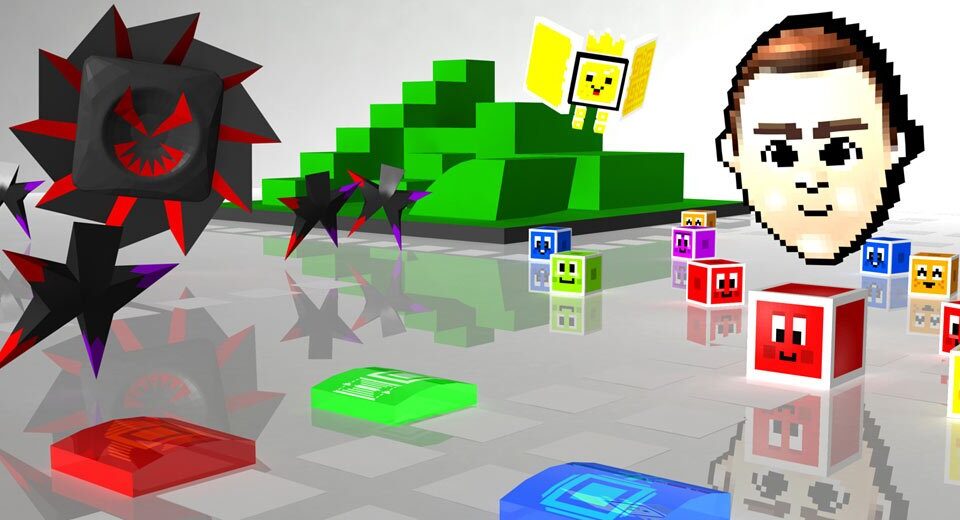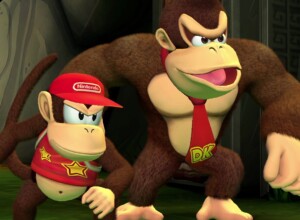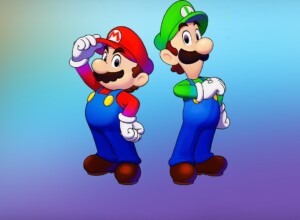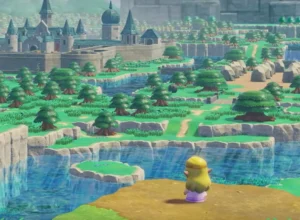Bit Boy!! Arcade is a difficult game to review. This may come across as an odd statement, but the problem with Bit Boy!! Arcade is that as a sum of all of its parts the game is simply bad. Yet it is wrong to also describe Bit Boy!! Arcade as a failure, for there are some interesting aspects and the implementation of the narrative into what is essentially a Pac-Man-esque arcade game is unique.
When the game launched its sole creator Bernd Geiblinger posted on Miiverse describing Bit Boy!! Arcade as a ‘Hardcore gamer action adventure’. It is important to highlight this statement as it helps to identify the type of person this game might appeal to. Put simply, if you do not consider yourself a gamer (regardless of which type) then this is not for you. This is a game that is deeply inspired by the past, so much so that it takes the majority of its gameplay from there as well as using the progression of video games as its underlying sub-plot.
The overall narrative of the game is what sets it apart and is what also prevents it from being dismissed altogether. It is loosely connected to a prior Bit Boy!! game which released on WiiWare a few years ago, and takes place after the titles “hero” Kubi dies. The start of Bit Boy!! Arcade sees the games creator Bernd praying to a magical god-like gear for the return of Kubi. Whilst the initial set-up is forgettable it is the implementation afterwards that is of interest. As unlike the vast majority of all other video games the creator, Bernd, is a main character in the game, acting as sort of guide for Kubi whilst at the same time a type of god; as in terms of the narrative he is responsible for the creation of the levels and enemies that Kubi deals with.
If this sounds a bit too Meta, that is because it is. Bernd has placed a pixel version of his own face into the game which hovers around and is always present on the lower screen during levels. In between and after levels Bernd will have one to one discussions with Kubi discussing the phases (each level has numerous phases, more on this later) that he has gone through and then, Kubi, in his aggravating, monotonous deep voice announces what he wants to see more of. It is during these sequences that Kubi comes off as pathetic creation that is somehow meant to represent the desires of the player. What follows is Bernd announcing how he will try to implement Kubi’s suggestions, further fulfilling his god-like role. The problem with this is that each instance of communication between the two ultimately consists of the same topic just portrayed slightly different.

During these conversations the subject of game design is frequently explored, stopping just sort of Bernd providing the player with any useful information, and before Kubi can have an existential crisis. There is some logic behind Bernd’s decision, as it is likely he does not want to overwhelm the player at that moment in time, as instead the “world map” contains sections which the player can navigate to and by doing so triggers Bernd to discuss an aspect of game design in more depth. Like the interactions with Kubi these are all voice acted by Bernd himself, with his Austrian accent helping to provide an almost scholarly feel.
However it is just a shame that that the actual game itself is monotonous, in large part due to the uninspired level design and the repetitive nature of the core gameplay mechanic. Bit Boy!! Arcade is split into different worlds and within each world are three standard levels and then the Boss level. The levels are split into phases, and after finishing the first ten the player can then access the “action” phases. These only differ slightly from the previous “normal” phases due to the increase of bombs and rockets. Each world is meant to represent a different main stage of video game design and with the advancement to new worlds brings with it more visually interesting arenas. Each level is different to one another, but united thematically based on the world, yet each phase will at most be a slightly different area of a level. The main difference between each phase is the placement of Kubi’s “friends”.
The main aim of Bit Boy!! Arcade is collecting (rescuing) these cubes; once Kubi has collected all of them he can then be guided to the portal to move onto the next phase. The second aim of Bit Boy!! Arcade is the collection of golden Pixel Flies, whilst their collection is not essential for the completion of each phase; they are essential for unlocking subsequent levels and Boss levels. Failure to collect enough means replaying the phases making them even more tedious.

Collecting Kubi’s Friends and the Pixel Flies is no easy task, as each phase (aside from the first of each level) contains numerous enemies, often including different types. These enemies are governed by rudimentary AI, but due to the way the arenas are laid out this to the benefit of the player, as it is required to quickly learn the basic routine of each enemy in order to progress. This is more in keeping with earlier video games, yet sometimes the enemies will deviate outside of what was assumed their programmed path, making one wonder whether this is by design or a glitch?
The enemies are just as bland as the level design, with the main humanoid enemy type being designed to only be able to turn right, yet this is sometimes redundant considering these enemies will sometimes rotate right on the same axis. Combine this with the fact that their uninspired visual design can at times make them difficult to distinguish from the background and from one another can lead to rage quit inducing moments. This is especially true when there are multiple humanoid enemies accompanied by a large spiral enemy, that looks like it could have been in the original Tron, are closely compacted into one small rectangular space with collectibles dotted in among them.
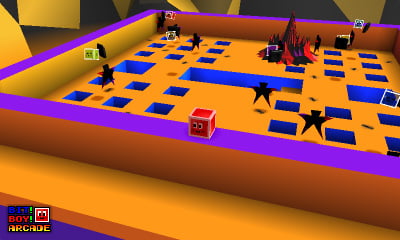
When thinking back to what made some of the classic video games of the past so memorable, one aspect was the responsiveness and the ease of the controls. A game could still be exceedingly difficult, but providing the controls were implemented in the right way the player would never blame them, and instead would focus on altering their strategy. Bit Boy!! Arcade does not share this approach. That is not to say that the controls are broken, just barely adequate. This is unfortunate as there was an attempt to make them unique. The wise decision was made not to associate movement controls to the circle pad, and instead use it for camera control. For movement the player can either use the face buttons of the d-pad, which is sensible considering the limited range of movement. Where the game tries to be unique is that in order to make Kubi run the player is required to quickly alternatively tap the d-pad and corresponding face button in the direction they want. In theory this makes sense, but the execution only just about works, and doing so means that controlling the camera is out of the equation.
The mediocre controls add to the frustration when trying to collect Kubi’s friends, as unlike the Pixel Flies which are picked up whilst traveling over them, you have to wait almost a second for this action to be completed. When frantically trying to do so whilst avoiding contact with an enemy or two is needlessly frustrating and often can result in accidentally failing to collect it and then having to try again. It is difficult to ascertain whether this is an attempt to increase the games challenge or just simply a poor design decision.
Irrespective of the design faults, on a technical level Bit Boy!! Arcade is quite impressive; especially considering it is a one person operation. The game utilises the 3DS hardware effectively, even providing a remarkable use of the system’s 3D capabilities, more so than many larger developers and without resorting to gimmicks. As Kubi progresses to different levels and worlds the actual locations become increasingly notable, bringing some visual delight among the dull enemy types and the unremarkable level structures. Furthermore the use of the 3DS’ Play Coins which act as credits to continue when you run out of the pre-supplied lives is intuitive.

Whilst the technical competence is a noteworthy achievement for one person, it feels that Bernd spent most of his time programming the game rather than designing it. It is admirable for a single individual to make an entire game, especially one of this length, as it cannot be said that one does not get their money’s worth with Bit Boy!! Arcade, but it would have benefitted greatly from at least one other individual to help out. This would have allowed Bernd either more time to focus on the design, or to let someone focus solely on the level design.
Overall Bit Boy!! Arcade is a deeply flawed game, but with some interesting yet poorly executed ideas. The use of the fourth wall breaking narrative is implemented in an intriguing way, but occasionally comes off as pretentious. Then there is the characterisation of Kubi, a distinctively unlikable character spouting basic desires like a needy child. As well as the relentlessly monotonous gameplay that fails to diversify as the game progresses. However there is plenty of content available with each level having a second set of “Action” phases, so for those who can find enjoyment in the gameplay on offer will have plenty to satisfy their purchase.
